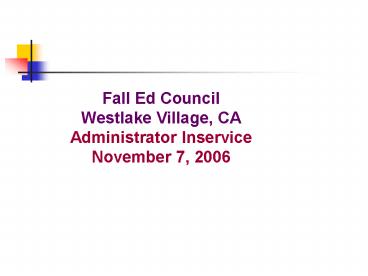Fall Ed Council Westlake Village, CA - PowerPoint PPT Presentation
1 / 16
Title:
Fall Ed Council Westlake Village, CA
Description:
Zmuda, Kuklis and Kline, ASCD, 2004. Journey to Excellence: A Focus on Adventist Education in the 21st Century, North American Division ... – PowerPoint PPT presentation
Number of Views:19
Avg rating:3.0/5.0
Title: Fall Ed Council Westlake Village, CA
1
Fall Ed CouncilWestlake Village,
CA Administrator Inservice November 7, 2006
2
Continuous School ImprovementThambi Thomas,
Associate Director - Secondary
- Resources
- Continuous School Improvement,
- Zmuda, Kuklis and Kline, ASCD, 2004
- Journey to Excellence
- A Focus on Adventist Education in the 21st
Century, North American Division Office of
Education, 2003 - Using Test Results
- Dr. James Cox, NEA-Alaska, JK Educational
Associates, 2000 - Data-Driven High School Reform THE BREAKING
RANKS MODEL
3
Continuous improvement may be defined as an
unwavering commitment to progress for all
students.
4
Model of Continuous School Improvement
5
Six Steps to Continuous School Improvement
6
Step 1 Identify and clarify the core beliefs
that define the schools culture
- Operating Principle
- Each school is a complex living system with
purpose - Application
- School/community profile
- Involvement of all the stakeholders in
identifying ESLRs/Schoolwide Goals - Schools mission statement
- Explanation
- Why does this school exist?
- What are the core values?
- Academics?
- Social and emotional?
- Spiritual?
- The schools core beliefs
- and values must be
- identified and embraced by
- all
7
Step 2 Create a shared vision by explicitly
defining what these core beliefs will look like
in practice
- Explanation
- Shared vision is a description of what is seen
and heard in every part of the school community - What do parents and students talk about?
- Operating Principles
- Shared vision translates to a coherent picture of
what the school will look like when the core
beliefs have been put into practice. - Shared vision represents perspectives of
shareholders - Application
- The Schoolwide goals
- Attainment of goals
8
Step 3 Collect accurate, detailed data and use
analysis of data (disaggregate data) to define
where the school is now and determine the gap
between reality and shared vision
- Explanation
- Collection and analysis of data leads to
- Honest assessment of teaching and learning
practices - Greater clarity on what must be done to achieve
the shared vision. - Application
- Analyze surveys, test scores and other assessment
data - Include in Chapter 1 Student and Constituency
Profile
- Operating Principles
- Staff gain clarity of their responsibilities
towards achieving the shared vision. - Validity and reliability in the gathering and
analyzing of data is important to understand what
is working well and to reveal the gaps between
reality and shared vision. - Inspires collective action
9
Breaking Ranks High Schools are able to
disaggregate data 9 strategies
- 1. Track the performance of specific student
groups on multiple measures, including students
participating in specific programs and students
in learning academies/communities, courses,
projects, or internships - 2. Profile performance by gender, language
proficiency, disability, socio-economic status
and other equity factors to identify achievement
gaps - 3. Analyze student performance at multiple
levels, including school, grade level, subject
area, program, course, classroom, and individual
student
10
Disaggregating data (continued)
- 4. Compare student course grades to other
standardized measures - 5. Determine how factors such as absence and
mobility affect assessment results - 6. Analyze trends in absence, suspension, and
dropout rates for specific student groups - 7. Profile longitudinal performance trends on
multiple measures - 8. Track the longitudinal performance of specific
student cohorts - 9. Make data-informed decisions about
instructional improvement.
11
Step 4 Identify innovations that will most
likely bridge the gap between reality and shared
vision
- Explanation
- Staff must have opportunity to learn what the
change is and its likely impact on students and
the school
- Operating Principles
- All staff must see staff development as a
necessary means to realizing the goal - There must be an intentional linkage between the
various components of staff development plans and
the goals to be reached
12
Step 5 Develop and implement an action plan that
supports teachers through the change process and
integrates the innovation within each classroom
- Explanation
- Staff must be trained, coached and supported
throughout the process - Resources must be allocated according to
individual staff needs - Leaders need to be responsive to specific
concerns and hold teachers accountable
- Operating Principles
- Staff development that fosters collaboration
- Planning that provides clear, concrete directions
necessary for systematic change - Application
- School Improvement Action Plan
13
Step 6 Embrace collective autonomy
(collaboration) as the only way to close the gaps
between current reality and shared vision and
embrace collective accountability.
- Explanation
- Student achievement is measured in order to
assess the core beliefs identified in Step 1.
- Operating Principles
- Everyone within the system performs according to
expectations - Everyone accepts accountability for improvements
- Application
- Capacity to follow-up
- Continuous improvement
14
Recap
- Step 1 Identify and clarify the core beliefs
that define the schools culture - Step 2 Create a shared vision by explicitly
defining what these core beliefs will look like
in practice - Step 3 Collect accurate, detailed data and
disaggregate data to define where the school is
now and determine the gap between reality and
shared vision
15
- Step 4 Identify innovations that will most
likely bridge the gap between reality and shared
vision - Step 5 Develop and implement an action plan that
supports teachers through the change process and
integrates the innovation within each classroom - Step 6 Embrace collective autonomy
(collaboration) as the only way to close the gaps
between current reality and shared vision and
embrace collective accountability
16
Excellence is not an act. It is a
habit. Aristotle































